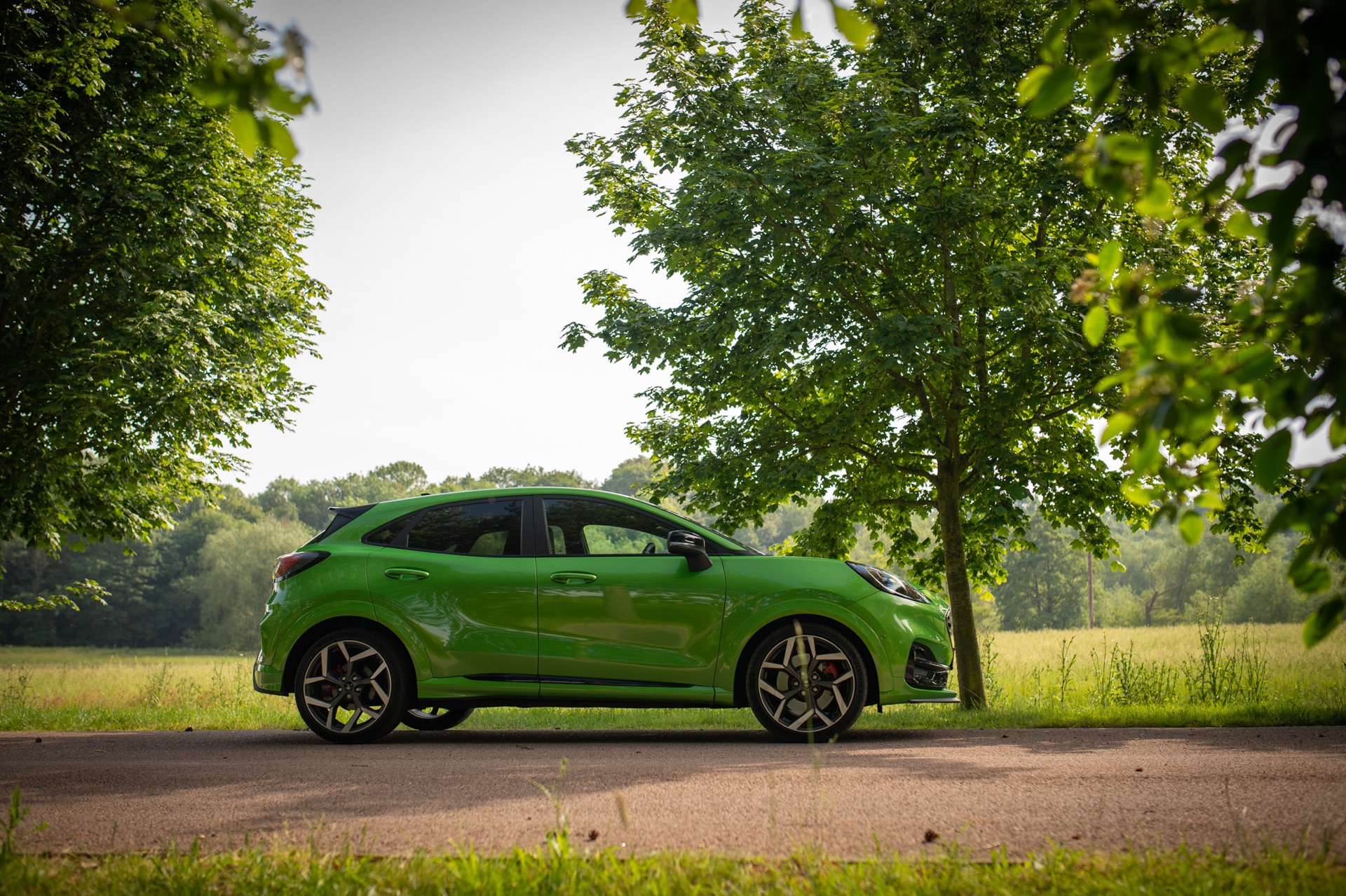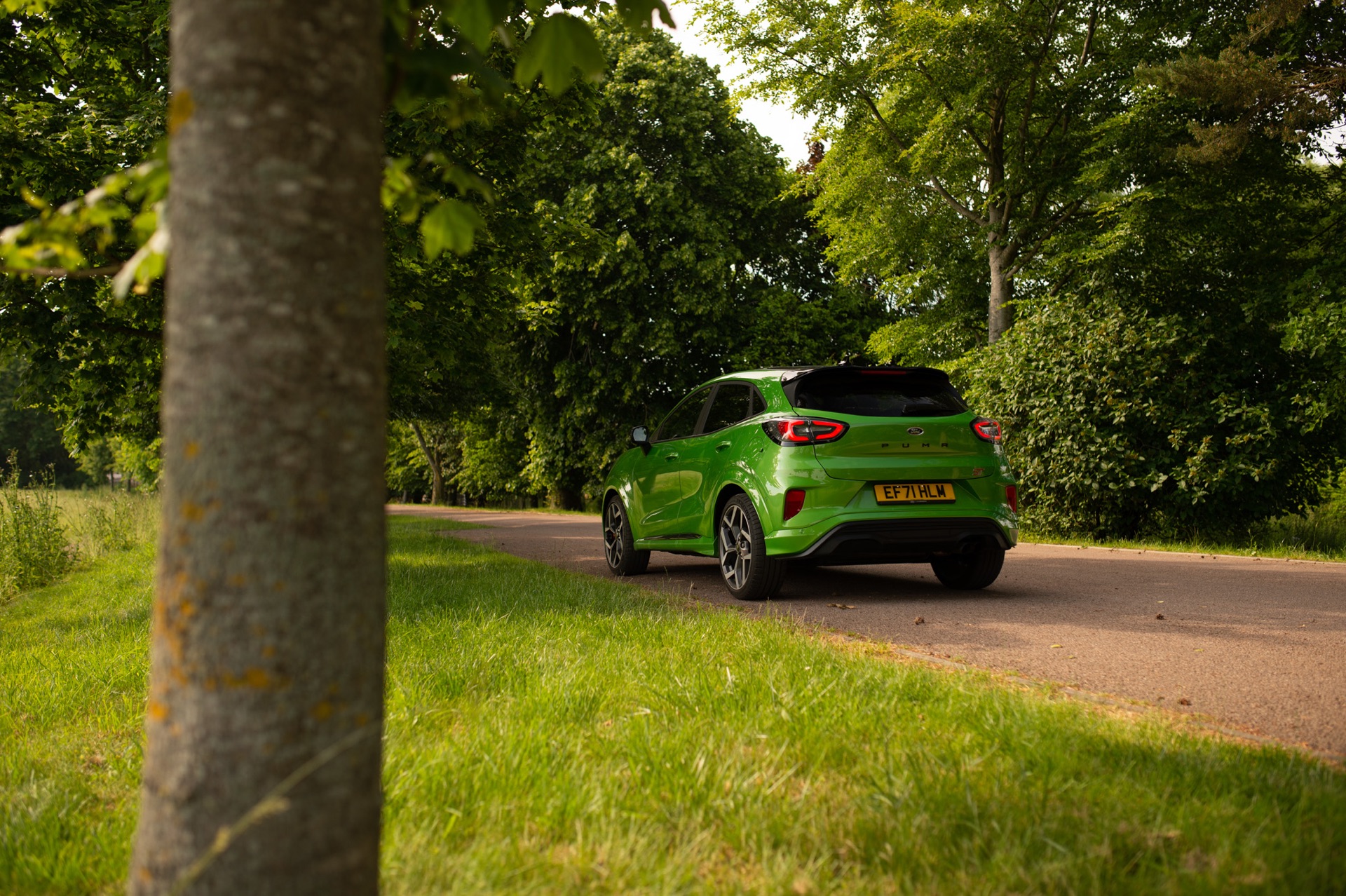However, it’s not all as mundane as it may seem. You’ll have by now noticed that this is the ST, and therefore has had a workover from Fords Performance department. Even better, the Pumas underpinnings are lifted straight from the sublime Fiesta ST. Still with me?
From the outset, I have to say I do not understand the need for a “Crossover”. However, the Puma is not just one of Britain’s best-selling Crossovers, its one of Britain’s best-selling cars full stop. Therefore I wouldn’t be doing my journalist due diligence if I didn’t give it a chance. But is this car for the average Crossover buyer, or for the enthusiast?
The car, as tested, has an RRP of £33,985. What did I say about bad first impressions? That’s expensive to say the least. The starting price for the Puma ST is around £5,000 more than its Fiesta blood brother, but given that Ford have decided to cull the Fiesta maybe that’s not the comparison we should use. Looking at the market, we find only two options in the sub £35,000 manual hot hatch arsenal. The Puma, and the Hyundai i20n, the latter starting at £26,230.
So what are you getting for this extra lump of cash? For starters, standard spec list is stocked well. Obviously, it comes with the “Performance Pack” (this used to be an option on both Fiesta ST and Puma ST, but now is standard) as well as a whole host of tech. Auto Parking, Auto lights and wipers, Navigation, CarPlay (not that I ever got it to work…) and a fantastic B&O Stereo. Once I spec a Fiesta ST up to that, we are closer to the £30k mark, which brings the gap down somewhat.
It’s fair to say the looks of the car divide opinion, especially this one painted in “Mean Green”. When it was first launched, I didn’t care for the styling at all, perhaps largely due to using the Puma name for something that wasn’t a little coupe. However, as time has passed, it’s growing on me. I even like the paint, which is an ST only choice. Unfortunately, Ford have decided to delete this colour option, perhaps an indication towards the sort of customer the Puma attracts. There are other ways to spot an ST model from your standard appliance however, courtesy of those 19” Wheels and the “Ford Performance” embossed splitter. That is of course if you’ve already missed the bright red ST badges, or slash cut twin tailpipes.
Moving inside, you’re greeted by yet more branding to remind you it’s the spicy variant. Ford Performance sill plaques, an ST wheel and the excellent bucket seats. They’re a bold choice in what is normally a car with an eye on practicality, the large bolsters making entry and exit from the drivers seat a little more tight than you may expect. Once you’re in them though, they’re incredibly comfortable and supportive. The final icing on the ST-Cake is the 6 speed shift knob, which is very welcome to see in an era of countless “paddle only” hot hatches. Its just a shame that the interior quality isn’t quite what you’d expect from a £30k+ car, but then again its pretty in line with most Ford products.
As previously stated, you also get most of the tech inside as standard. The touchscreen infotainment unit, which can be dim witted at times, is paired with an excellent B&O stereo system. I just wish it was more intuitive to use, I never worked out how to get Apple CarPlay working for my phone! Thankfully all the HVAC controls have physical buttons, they only use the display to show you what you’re on. Which, again, can be frustrated when it lags behind your input. The same is true of the digital dash, which at times looked like I was trying to load it via dial up. It’s worth noting that for when the British weather gets a tad more British, you also get: heated seats, steering wheel, quick clear windscreen, auto lights and auto wipers. But since its summer, only the air conditioning got a thorough workout on this test. Of the non-paint options fitted, the active tailgate was probably the most useful. For £400 you can open the boot by wiggling your foot underneath the rear bumper, and close it with a button. The “Driver Assistance Pack”, which list of features includes the word “active” more than once, does include some very good parking cameras. That said, it also includes the ability to park itself, so in theory you don’t need them right?

But enough chat about fixtures and fittings for now, hot hatches are all about how they drive, not that I was entirely sure that was going to be the case here. I think I was expecting a Fiesta ST with the edges blunted off, an every so slightly softened up approach to formula. Within a mile, that assumption was completely blown out of the water. Just leaving my village out onto a B road, the car was pulling on every little bit of camber, seemingly a homing device for all potholes. I even assumed it had lane assist turned on at one point, but it didn’t. This really has a geometry like a MK1 Focus RS, its all about the turn in and handling, less so about the day-to-day errands. Couple that with a pretty harsh ride, I’m once again asking myself “who is this car for?”. Here we are with those bad first impressions again…
Whilst the car does feel oddly nervous, it’s clear they’ve not diluted the ST Recipe, which should be applauded. I guess from now on I must assume we have a driver’s car here, an enthusiast option, and peddle it accordingly. Theres plenty going on underneath to support that argument, too. A Mechanical LSD, Launch Control, Sport and Track modes all on offer here. It would be rude not to show it some of my favourite test routes.

My first bit of stomping ground is a real test for a cars suspension, I wont name-names but it’s also used by a local farmer. Let’s just say his Youtube channel rhymes with Garys Harrage. Either way, the Pumas damping instantly impressed. Perhaps on the firm side when pottering around, when you start layering on some speed it handles nearly all that’s thrown at it exceedingly well. Some of the compressions on that route are real bump-stop finders, too. Couple that with good steering feel, and the unwavering grip from the Michelin PS4S’, and we have a bit of a weapon on our hands.
And whilst it isn’t what you’d call fast, (The 3 cylinder, 1.6 Turbo is unchanged from the Fiesta with 197bhp. But with around 150kg extra mass to haul around) the dynamics of the car more than make up for it. I also love a hot-hatch you can rev out without breaking the law, and this little ecoboost motor can be quite addictive. The 3 pot noise, the crackles from the exhaust and of course the faint chirp from the Turbo when you lift off. No matter how much is synthesised, I’m all the happier to listen to it.

You may have noticed, I’ve spoken mainly about the in-family feud Ford has between this and the Fiesta. However, since Ford are solving that by means of execution, perhaps I should talk more about the Korean Elephant in the room. The Hyundai i20n. It too is a 1.6T with 200bhp, a 6 Speed manual and an LSD. But it’s £5,000 cheaper. The Puma does feel a little more refined, with better materials it’s true, but I still can’t get over that price.
Whilst I’m being sensible, it’s probably time we circled back round to the boring subject of practicality. That is after all why you buy a hot hatch, and it’s especially why people seem to buy a crossover. The truth is that the rear seats seem to offer no more room than a fiesta, and the sloping roof means it can feel a bit dark and claustrophobic back there. The boot space however is much larger, measuring 456L verses the Fiestas 292L and I20’s 352L. You also get something called the “megabox”, a huge area of storage under the boot floor which is waterproof and has drain plugs too!

After a whole week with the car, it was difficult to sum up a conclusion. On the one hand, I still can’t quite fathom who its actually meant for. On the other, I applaud Ford for making it at all. Perhaps it is for the enthusiast who needs to carry a little more around than a regular hatch can fit? Or maybe it’s for the crossover buyer who wants something a little sporty?
Either way, it’s living proof that with the right engineers, you can make almost any genre of car fun to drive fast. If brands are moving away from the classic super-mini towards this type of vehicle, I’m glad someone is still flying the flag for the Hot Hatch regardless. For me though? If I was in the market for a brand new small hot hatch right now, there are only two choices: I would be in the Hyundai, but only by a whisker.

































